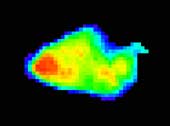|
COMETS EARTH JUPITER KUIPER BELT MARS MERCURY METEORITES NEPTUNE OORT CLOUD PLUTO SATURN SOLAR SYSTEM SPACE SUN URANUS VENUS ORDER PRINTS
PHOTO CATEGORIES SCIENCEVIEWS AMERICAN INDIAN AMPHIBIANS BIRDS BUGS FINE ART FOSSILS THE ISLANDS HISTORICAL PHOTOS MAMMALS OTHER PARKS PLANTS RELIGIOUS REPTILES SCIENCEVIEWS PRINTS
|
Related Document
Download Options
False colors emphasize the variations in surface brightness on asteroid Annefrank, as seen in an image taken by NASA's Stardust spacecraft during a November 2 flyby of the asteroid. Stardust flew within about 3,300 kilometers (2,050 miles) of the asteroid as a rehearsal for the spacecraft's encounter with its primary target, comet Wild 2, in January 2004. The variations in surface brightness result from different angles of solar illumination, as well as from intrinsic variations in the surface. The straight edge at the right side of the asteroid's image may be an artifact of processing. Stardust will bring samples of comet dust back to Earth in 2006 to help answer fundamental questions about the origins of the solar system. |
